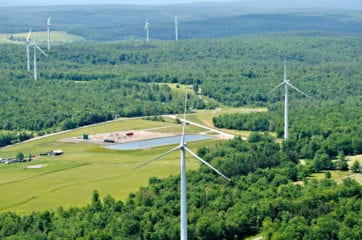Waste management in the United States, particularly through incineration, is a major environmental justice concern. A global economic model of overconsumption has resulted in social and environmental emergencies, one of which is properly disposing of waste products.
In the context of the climate crisis, the burning of trash is a practice that is at the very least counterintuitive because it releases heat-trapping gasses, but more importantly is hazardous to the health of people who live nearby burn sites. Most of these facilities are located in frontline communities, ones that are disproportionately burdened with, and least equipped to deal with, the effects of environmental harms.
Chester, Pennsylvania is the site of one of the largest trash incinerators in the United States and their public health crisis illustrates the major impact of environmental racism. Chester residents have been organizing for 30 years to reshape their community and are currently attempting to end their city’s contract with the incinerator.
Waste Management Policies in the U.S.
The United States’ policy regarding the management of waste mainly revolves around the Resource Conservation and Recovery Act (RCRA) of 1976. This legislation gave the Environmental Protection Agency (EPA) the authority to develop regulations, guidance, and policies regarding how to handle municipal solid waste, which includes organic waste, recyclable materials, and other disposable goods. Individual states are then left to implement these policies while making sure they meet the standards set by the EPA.
Under the authority of RCRA, the EPA developed a hierarchy of waste management solutions, ranked from most preferable to least. The most desirable solution to managing waste is the reduction and reuse of materials. The second best option is to recycle or compost anything that can’t be immediately reused. If something can’t be recycled, the EPA says that waste should be burned to produce energy at a facility such as a power plant. The final and least preferred solution is treatment and disposal of waste. This includes reducing the volume and toxicity of waste and ultimately dumping it into a landfill.
Burning What We Can’t (Or Won’t) Recycle
The process of burning trash in incinerators is known as Waste-to-Energy (WTE), because the heat from combustion can be used to produce electricity, in the same way that a coal power plant would. This strategy is controversial among environmentalists in terms of the effectiveness and safety of these facilities. Proponents of WTE argue that it is preferable to dumping trash in landfills, which are known to release large amounts of methane, a gas that traps 25 times more heat than carbon dioxide. Secondly, WTE does produce electricity and in some states it is considered to be a renewable resource because of the organic components, such as food and plant material.
Adrienne Perovich, co-author of The New School’s 2019 report, U.S. Municipal Solid Waste Incinerators: An Industry in Decline, however, told Climate XChange that the benefits of WTE are not all that they seem. “The entire concept of the incineration industry trying to rebrand themselves as Waste-to-Energy is just fundamentally false. It’s the most inefficient and expensive way to produce energy. It’s also extremely dirty for local residents and for the climate.” In fact, electricity generated from WTE accounted for only 0.5% of the total electricity produced in the United States in 2020. The New School’s report also highlights that the average age of incinerators in the U.S. is 31 years, and with a operating life of only around 30 years, they will need to see large investments to continue to operate into the future.
The waste management challenges in the United States have been compounded in the last few years since China’s 2018 ban on certain waste imports. Before the ban, the United States was exporting 70% of its collected plastic to China. Some hoped this would encourage the United States to reinvest in its own recycling programs, but Perovich says we still have a long way to go. “We’re nowhere near where we need to be in terms of waste management and domestic recycling infrastructure. We also really have to look at the petrochemical industry and natural gas fracking, and how we’re using that fracked natural gas to produce single use plastics.”
It should also be noted that despite China’s ban on plastic imports, the United States has instead increased exports of the recyclable material — mostly to other countries in Southeast Asia. This comes after the U.S. was one of the only governments not to ratify the global agreement to ban shipping plastic waste from richer to poorer countries. In 2018, plastic accounted for 12.2% of overall waste generation in the U.S. Without government incentives or mandates to reduce pollution, the significant portion of plastics in waste signals to the petrochemical industry that they should continue production of single use plastic materials.
Environmental Racism and Waste-to-Energy
The United Church of Christ Commission for Racial Justice’s 1987 report, Toxic Wastes and Race in the United States is largely credited as one of the foundational publications on environmental justice. Among other things, the report found that race was the key indicator to living within proximity to hazardous waste facilities. More than thirty years later, this trend continues with waste incinerators. The New School report found that 79% of the nation’s WTE facilities are in “environmental justice communities.”
The location of these incinerators is, among other reasons, the result of historic racial segregation in urban planning that allowed whiter, more affluent communities to exclude people of color and unwanted industrial zones. Living near industrial zones — often where incinerators are located — decreases property values, can increase taxes to maintain the facilities, and stigmatizes the community as a literal dumping ground for waste. Additionally, exclusionary zoning practices, such as restricting multi-family dwellings from some neighborhoods, make it difficult for people who can’t afford to purchase single-family homes to live in less polluted communities.
And because waste production increases with wealth, this means that the communities who suffer from these sacrifice zones are contributing the least to the problem. Higher income has been found to be the biggest contributor to environmental impact, even for people who make “green” lifestyle choices. Overconsumption is common in Western cultures, however many communities of color come from non-Western backgrounds that have a history of more sustainable living.
Cumulative Impacts of Pollution from a “Green” Process
Incinerators are known to emit pollutants such as particulate matter (small airborne particles), lead, carcinogenic dioxins, and mercury — all of which are hazardous to human health. Perovich told Climate XChange that the cumulative impacts of these pollutants is the biggest health concern around incinerators. “It’s not just individual polluters that are the issue, it’s the cumulation of all sources of pollution in a geographic area. Cumulative impacts of pollution consider sensitive populations and socio-economic factors.” In other words, it’s important to step back and view all of the sources of a community’s pollution, incinerators being one of many. This is an important distinction when considering the permits that are granted to WTE facilities which allow “safe” levels of pollution determined by the EPA. Some pollutants, like particulate matter, have been found to have no safe minimum exposure levels.
The Clean Air Act of 1970 directed the EPA to reduce emissions risk “sufficiently” and protect public health with an “adequate margin of safety.” State regulatory agencies are responsible for approving permits that require facilities’ emissions to stay within these margins. This means that one incinerator may emit an acceptable amount of particulate matter, but when other polluters in the area are considered, the levels may exceed safe limits. The combined impacts of other polluters in areas aren’t well known or regulated. Perovich also says that the idea of cumulative impacts considers other socioeconomic and demographic factors in an area. “Poverty rates, education rates, cancer rates, all of these things impact how somebody is affected by these various types of pollution in their community.” Depending on all these factors, cumulative impacts of pollution can affect one community more than another. For example, people living in poverty may not have adequate access to medical care and would be more vulnerable to the effects of health issues like asthma, lead poisoning, and other harmful pollutants.
Delaware Valley Resource Recovery Facility in Chester, PA
Chester, PA is the only city in Delaware County and it’s one of the clearest examples of historic environmental injustice in the United States. Like many cities, Chester experienced economic decline after World War II due to the closing of industries, political corruption, and systemic racism. After the civil rights movement in the 1960s, the city’s demographics began to shift; White populations fell, and Chester saw an increased number of people of color. Today, Chester’s population is 17.1 % white, 68.9% black, and 11.6% latinx, and more than a quarter of the residents live below the poverty line.
During the 1980s, investors began looking at Chester as a good location for waste facilities as landfills reached capacity in other parts of the state. In 1991, the city opened a WTE facility on the banks of the Delaware River. The incinerator, now known as the Delaware Valley Resource Recovery Facility, is among several waste treatment plants in the area. The facility has been opposed by local residents since the year it opened.
Chester Residents Concerned for Quality Living (CRCQL) was founded in 1992 in response to the negative impacts seen in the communities next to facilities like the Delaware Valley incinerator. Zulene Mayfield, the founder of CRCQL, told Climate XChange that she has mixed feelings about her organization. She said, “After thirty years, I’m very proud that we are still together as an organization, but I’m very angry that we still have a tremendous problem.”
Mayfield speaks plainly about the problems in her community. “I don’t want to be a waste manager. All I want to do is be a resident and live in comfort and peace,” Mayfield told Climate XChange about a member in her community who had been living in her home for more than 50 years and was recently told by their doctor that the city’s air pollution made it unsafe for her to even open a window.
Among the impacts on the community, the most serious is the incinerator’s effect on public health. A 2010 study found that the rate of asthma among children in Chester is five times higher than the national average. Covanta, the company that now owns the Delaware Valley incinerator, claims that because their pollutants are below permitted levels, the emissions are safe for the public. It is important to note that the Delaware Valley incinerator conducts their own monitoring and lacks certain pollution controls that are common in most WTE facilities.
Because regulations fail to consider the cumulative impacts of pollution, other sources of harmful substances are overlooked in Chester. Every day more than 300 trucks drive down the city streets and bring with them more pollution, foul smells, dust, and fumes that are not considered in the reporting of emissions from the Delaware Valley facility. While good air quality is something that every community deserves, Chester has gotten the short end of the stick. Even though Chester bears the brunt of the issues from the Delaware Valley site, only 2% of the waste comes from the city.
In early May 2021, the Delaware County Solid Waste Authority held a public meeting regarding the renewal of Covanta’s contract. Mayfield says that the meeting had a high turnout, but that the road forward is far from simple. Even though she’s been fighting for the past thirty years, she remains hopeful. “These are not microwavable battles, but if I didn’t think that we could close the [incinerator], I wouldn’t be doing the work.”
Polluter Pays Model
Waste management in the United States largely relies on a “consumer pays” philosophy. Whether the technique is recycling, incineration, or a landfill, it’s most often consumers who are responsible. Consumers “pay” with increased taxes, greenhouse gas emissions, and in the case of many frontline communities, their own health.
There are increased calls for the adoption of a “polluter pays” principle. The idea behind this is when a company pollutes or makes a single use good, like a plastic bottle, it should be their responsibility to properly handle its end of life. One way this can be done is to force companies to manage the collection and recycling of their own goods. Some states have begun to adopt this policy with electronic waste, which can leak heavy metals into groundwater when disposed of improperly.
The polluter pays principle can be hard to implement, however in 2019 the European Union passed a policy that makes big strides. Among other requirements, the Directive on single use plastics introduces Extended Producer Responsibility schemes on manufacturers. These mechanisms would require plastic producers to cover the costs of waste management, gather data, and educate the public on reusable alternatives as well as the impacts of improper disposal of their goods.
In March 2021, the Break Free From Plastic Pollution Act was reintroduced into the U.S. Senate after facing criticism last year because it called for Extended Producer Responsibility schemes, like the EU’s Directive. The bill’s sponsors are hopeful for success this year because of the growing support from environmental groups and legislators.
Through whatever means this transition is accomplished, environmental justice must be prioritized in the solutions. Chester is a powerful example of a community in which, despite contributing little to the problem, is paying disproportionately for the solutions. Zulene Mayfield says that public education and awareness are important first steps to helping communities like hers. “You can’t just put a bag of trash out on the curb and not care about where it goes, and who it impacts. Our ask as a community is to give our children a chance to breathe.”








